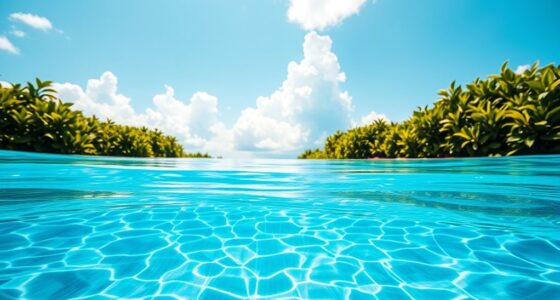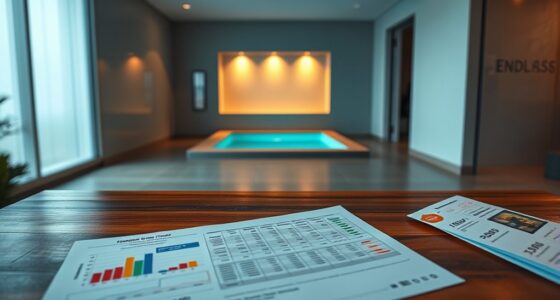To keep your endless pool crystal clear, start by understanding basic water chemistry. Regularly test your pH (aim for 7.2-7.6), chlorine levels (1-3 ppm), and alkalinity (80-120 ppm). Balance these chemicals to prevent cloudiness, algae, and equipment damage. Proper filtration and routine maintenance like cleaning filters and brushing surfaces also help. If you stay on top of these steps, you’ll enjoy sparkling water, and you’ll discover many more simple tips to maintain your pool’s perfect condition.
Key Takeaways
- Regularly test water chemistry, including pH, chlorine, and alkalinity, to maintain optimal balance.
- Keep pH between 7.2 and 7.6 for effective sanitization and water clarity.
- Maintain chlorine levels between 1-3 ppm to ensure safe, bacteria-free water.
- Use filtration, brushing, and vacuuming weekly to prevent algae and cloudiness.
- Adjust chemicals promptly to correct imbalances and keep water crystal clear.
Understanding Your Endless Pool’s Water Chemistry
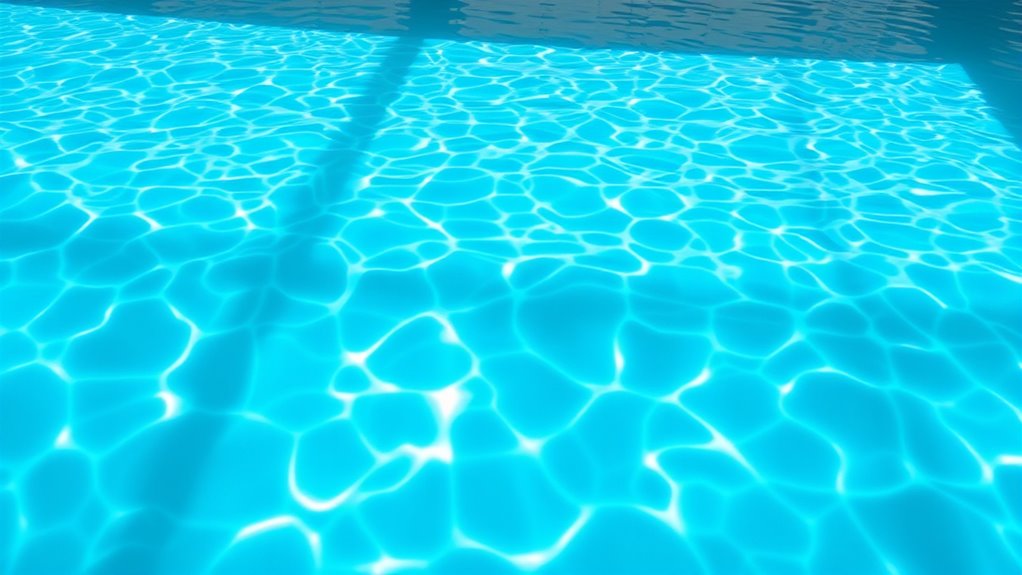
Understanding your Endless Pool’s water chemistry is essential to keep the water clean, safe, and comfortable. When you know how different elements work together, you can prevent problems before they start. The key components you should monitor are pH, disinfectants, and alkalinity. These elements influence each other and overall water quality. If the pH is too high or too low, chlorine and other disinfectants won’t work effectively, risking bacteria and algae growth. Maintaining proper levels ensures your pool stays clear and inviting. Regular testing helps you catch imbalances early, so you can adjust chemicals accordingly. Keeping your water chemistry balanced isn’t complicated once you understand the basics. It’s about creating a safe, pleasant environment for your swimming enjoyment. Understanding your pool’s water chemistry can also help improve the longevity and performance of your pool equipment.
The Basics of Ph and Why It Matters

Maintaining proper pH levels is fundamental to keeping your pool water balanced and safe. pH measures how acidic or alkaline your water is, affecting comfort and chemical effectiveness. If pH is too low, water becomes corrosive, damaging equipment and irritating your skin. If it’s too high, water gets cloudy and chemicals don’t work properly. Ideal pH levels range from 7.2 to 7.8. Here’s a quick overview:
| pH Level | Effect |
|---|---|
| 6.8 – 7.2 | Slightly acidic, can cause corrosion |
| 7.2 – 7.8 | Ideal range, safe and balanced |
| 7.8 – 8.0 | Slightly alkaline, may cause cloudiness |
| 8.0+ | Too alkaline, reduces sanitizer effectiveness |
Maintaining the correct pH helps ensure your chemical balance stays optimal and your water remains clear.
Chlorine and Disinfection: Keeping Your Water Safe
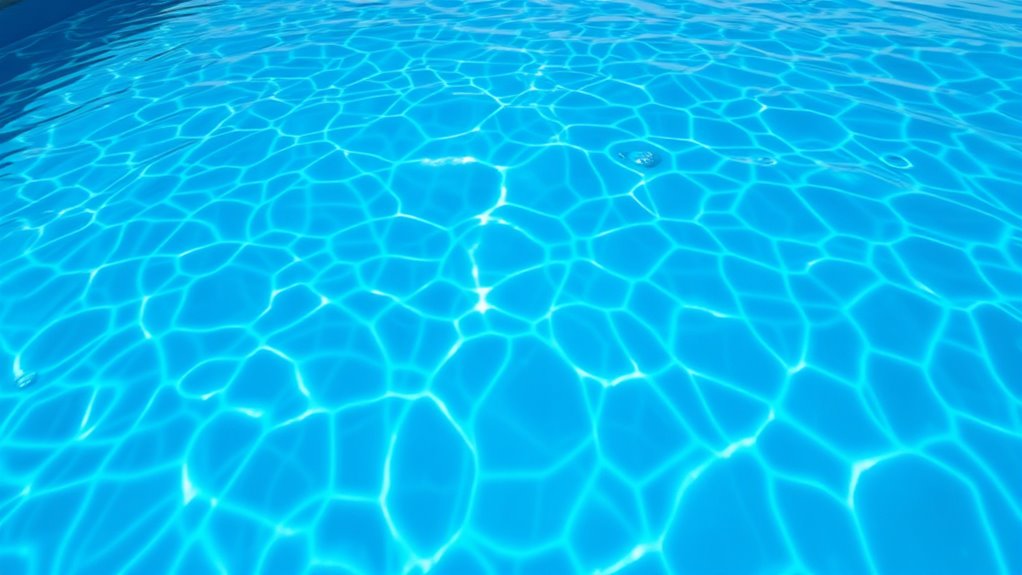
Chlorine plays a crucial role in keeping your pool water safe by effectively killing bacteria, viruses, and algae. It acts as a disinfectant, preventing harmful microorganisms from thriving and causing illnesses. When you add chlorine, it forms compounds that attack and destroy contaminants, ensuring your water remains clean and safe for swimming. Regular chlorination helps control algae growth and keeps the water clear and inviting. You need to monitor chlorine levels with test strips or kits and maintain them within the recommended range, usually between 1 and 3 ppm. Too little chlorine allows bacteria to multiply, while too much can cause skin irritation or strong odors. Proper disinfection creates a healthy swimming environment, giving you peace of mind every time you immerse yourself. Monitoring techniques are essential to maintain optimal chlorine levels and ensure safe water quality.
Alkalinity and Buffering: Maintaining Balance
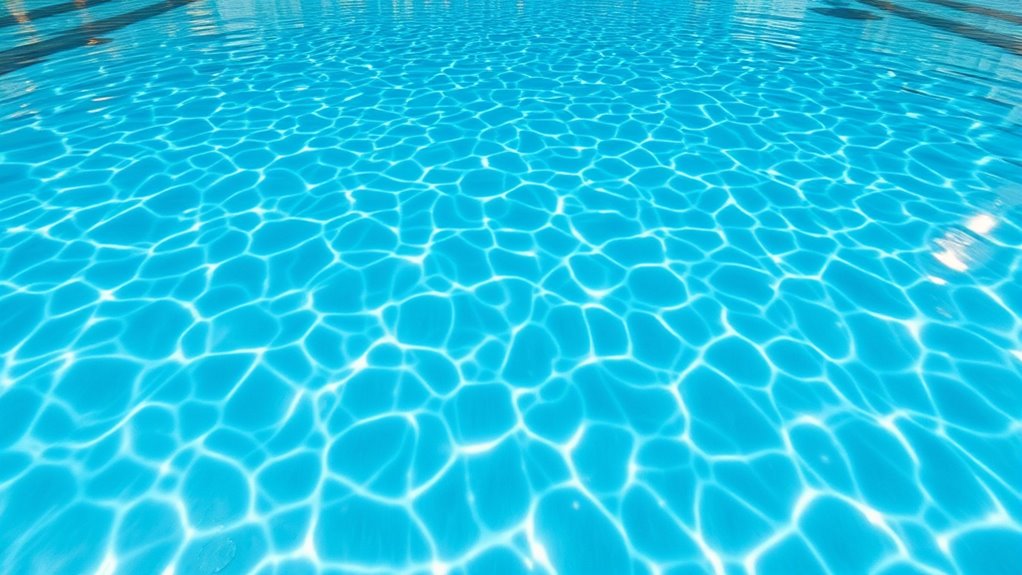
While keeping your pool water safe involves proper chlorine levels, it’s equally important to pay attention to alkalinity. Alkalinity acts as a buffer, preventing sudden pH swings that can cause cloudy water or damage your equipment. You want your alkalinity to stay within 80-120 ppm. If it’s too low, your pH can fluctuate wildly, making water unsafe and uncomfortable. If it’s too high, water can become cloudy and scale can form on surfaces. To maintain balance, regularly test your alkalinity levels with a test kit. If needed, add sodium bicarbonate (baking soda) to increase alkalinity or use muriatic acid to lower it. Keeping alkalinity stable helps your pH stay consistent, ensuring clear, healthy water and a more enjoyable swimming experience. Proper testing methods are essential to accurately monitor and maintain your pool’s chemistry.
Recognizing and Controlling Water Cloudiness
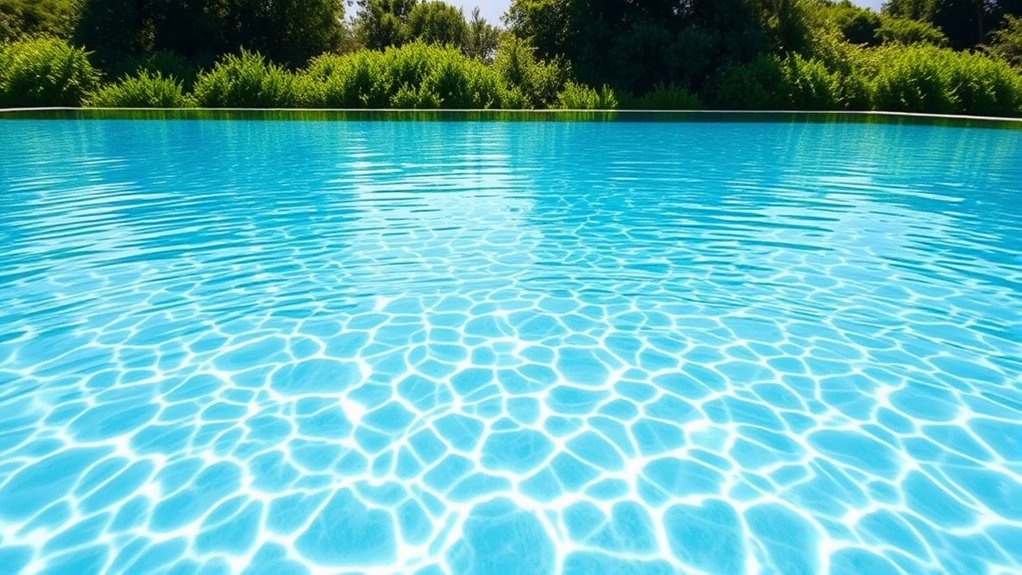
Have you ever noticed your pool water turning cloudy? It’s a common sign that something’s off with your water chemistry. Cloudiness can result from excess organic matter, algae growth, or inadequate filtration. When your water isn’t properly balanced, particles suspend in the water, making it appear hazy. To control this, start by ensuring your filter is working efficiently and running long enough each day. Next, shock the pool with a chlorine boost if algae or bacteria are present. Regular brushing and vacuuming help remove debris clinging to surfaces. Maintaining proper chemical levels, especially stabilizer and sanitizer, prevents cloudiness from recurring. Staying vigilant and responding promptly keeps your pool water clear, inviting, and safe for swimming. Additionally, monitoring signs of spoilage in pool chemicals can help prevent cloudiness caused by degraded or contaminated products.
Testing Your Water: Tools and Techniques

Testing your water accurately is essential for maintaining a healthy and clear pool. You’ll need reliable tools like test strips or liquid test kits. Test strips are quick and easy—they change color based on the water’s chemistry, and you compare them to a color chart. Liquid test kits are more precise; you add drops of chemicals to a water sample and observe the color change. To get accurate results, always collect water from elbow-depth and avoid testing after heavy rain or chemical additions. Follow the instructions carefully, and record your readings regularly. Keeping track of your test results helps you spot imbalances early. With consistent testing, you can maintain proper chemical levels and enjoy clear, safe water all season long. Understanding your water’s water quality helps you choose the right tests and maintain optimal conditions.
Common Problems and Simple Solutions
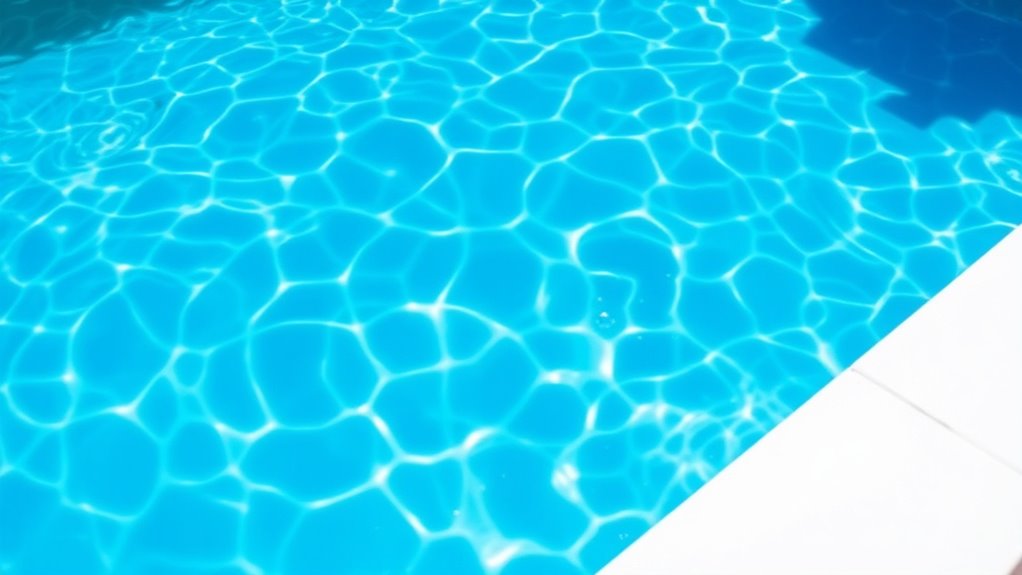
If your pool water isn’t clear or comfortable, you might need to adjust your chemistry. Balancing pH levels, managing chlorine, and preventing algae growth are common issues you can fix easily. Staying on top of these problems keeps your pool safe and inviting. Remember, consistent water testing helps maintain the proper chemical balance and prevents future problems.
Balancing Ph Levels
Wondering why your pool water feels off or looks cloudy? It’s likely due to unbalanced pH levels. When pH is too low, the water becomes acidic, causing skin irritation and corrosion of pool equipment. Too high, and the water gets cloudy, algae can grow, and chlorine becomes less effective. To keep your water crystal clear, test the pH regularly with a reliable kit. The ideal range is between 7.2 and 7.6. If pH is too low, add a pH increaser like baking soda. If it’s too high, use a pH reducer such as muriatic acid. Always follow the instructions on the product label and retest after treatment. Maintaining balanced pH levels keeps your water safe, comfortable, and sparkling clean. Regularly checking and adjusting pH also helps prevent issues like corrosion of pool equipment, ensuring your pool stays in top condition.
Managing Chlorine Levels
Are you noticing that your pool water isn’t as clean or clear as it should be? If so, your chlorine levels might be off. Too little chlorine allows bacteria and algae to grow, making the water cloudy and unsafe. Too much can cause skin irritation and strong chemical smells. To manage chlorine levels, test your water regularly with test strips or a kit. Keep chlorine levels between 1-3 ppm for ideal sanitation. If levels are low, add chlorine tablets or liquid chlorine to boost them. If they’re too high, wait a day or two for levels to drop naturally or dilute the water with fresh supply. Consistent testing and adjusting will keep your water crystal clear and safe for swimming. Monitoring chemical balance is essential for maintaining optimal water quality and preventing common problems.
Preventing Algae Growth
Maintaining proper chlorine levels helps keep your pool water clean, but algae can still become a problem if conditions favor its growth. Algae thrives in warm, stagnant, or poorly circulated water with insufficient sanitizer. To prevent algae, guarantee your chlorine levels stay consistent, especially during hot weather or heavy use. Regularly brushing the walls and floor helps prevent algae spores from settling and growing. Keep your pool’s pH balanced between 7.2 and 7.6, as proper pH prevents sanitizer from working effectively. Using an algaecide as a preventive measure can also help, especially at the start of the swimming season. Consistent maintenance, proper water circulation, and monitoring chemical levels are your best defenses against algae growth, keeping your pool crystal-clear and inviting. Additionally, staying informed about AI security vulnerabilities can help ensure your pool’s control systems remain protected from cyber threats.
Tips for Ongoing Pool Maintenance
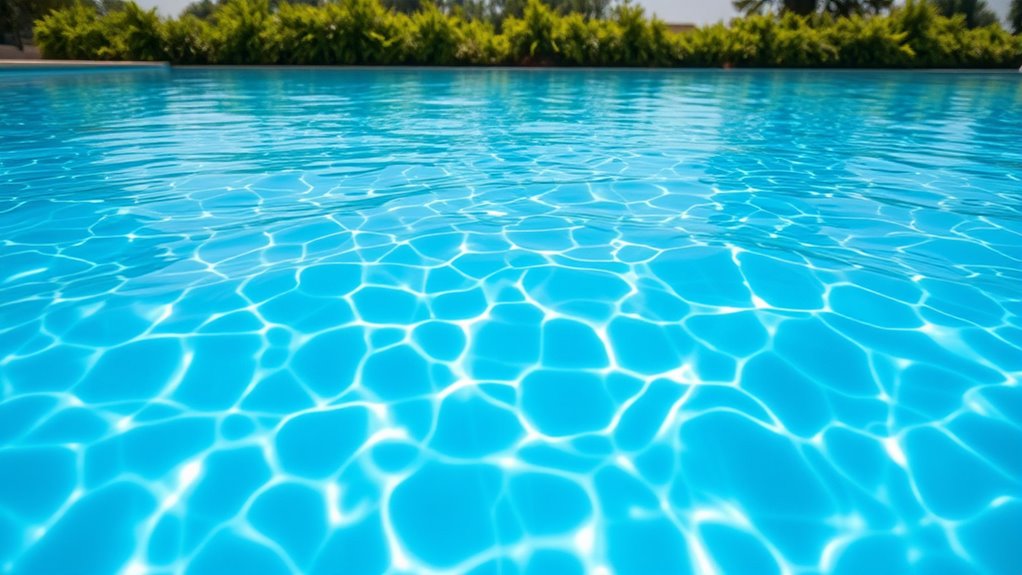
To keep your pool clean and safe, regular maintenance is essential. Staying on top of tasks ensures your water stays crystal clear and inviting. Here are four key tips for ongoing pool upkeep:
- Test and adjust water chemistry weekly to maintain proper pH and sanitizer levels.
- Skim debris daily to prevent buildup and algae growth.
- Vacuum the pool weekly to remove dirt and prevent cloudiness.
- Clean filters regularly to guarantee ideal circulation and water clarity.
Frequently Asked Questions
How Often Should I Test My Pool Water?
You should test your pool water at least 2-3 times a week to maintain ideal clarity and safety. If you notice cloudy water, strong odors, or skin irritation, test more frequently. Use a reliable test kit to check pH, chlorine levels, and alkalinity. Regular testing helps you catch imbalances early, so you can adjust chemicals promptly, ensuring your pool stays clean, safe, and inviting for every swim.
Can I Use Pool Chemicals From Different Brands Together?
Mixing different brands of pool chemicals isn’t recommended, as compatibility varies. Studies show that improper chemical combinations can reduce effectiveness or create dangerous reactions. You should always follow the manufacturer’s instructions and use products from the same brand for best results. If you need to combine chemicals, consult your pool supplier or a professional to guarantee safety. Consistent, correct chemical use keeps your pool water clear and safe.
What Are Signs of a Chemical Imbalance in My Pool?
You’ll notice cloudy water, a strong chemical smell, or skin and eye irritation, which are signs of a chemical imbalance. Your pH might be too high or low, causing these issues. Also, if chlorine levels are inconsistent or if you see algae growth, it indicates imbalance. Regular testing and adjusting chemicals help maintain proper levels, ensuring your pool stays clean, clear, and safe for swimming.
How Does Weather Affect Water Chemistry?
Weather subtly influences your pool’s water chemistry, so it’s worth paying attention. Hot, sunny days can cause your water to evaporate faster, concentrating chemicals and potentially leading to cloudiness or imbalance. Conversely, rain introduces new water and dilutes chemical levels, possibly making your water less sanitized. Wind stirs debris, affecting clarity. Regular testing and adjusting chemicals accordingly help maintain that perfectly clear, inviting pool, no matter the weather.
Is It Necessary to Drain and Refill My Pool Regularly?
Yes, you should drain and refill your pool periodically. Over time, minerals, algae, and other contaminants build up, which can affect water quality and chemistry balance. Regularly draining and refilling helps maintain clear, healthy water, reduces the need for excessive chemical use, and prevents issues like cloudy water or algae growth. How often depends on usage and water quality, but a good rule of thumb is every few months.
Conclusion
Keeping your endless pool crystal clear is easy when you understand its chemistry. Imagine a summer day, relaxing in pristine water that’s perfectly balanced—no cloudy surprises, just pure refreshment. Regular testing and simple adjustments, like adding chlorine or balancing pH, make all the difference. With steady maintenance, your pool stays inviting and safe, ready for spontaneous swims or peaceful laps anytime. Trust these basics, and your endless pool will remain a sparkling oasis year-round.



